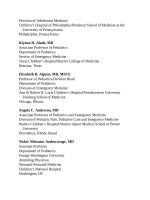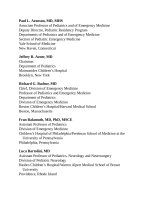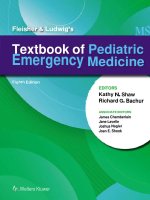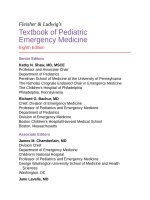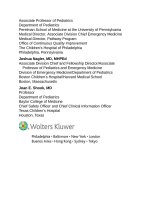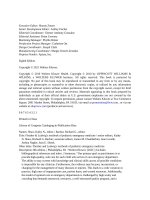Pediatric emergency medicine trisk 0223 0223
Bạn đang xem bản rút gọn của tài liệu. Xem và tải ngay bản đầy đủ của tài liệu tại đây (101.75 KB, 1 trang )
anterior–posterior, immediately at the beginning of the resuscitation and aid in
preventing delays in rhythm checks and treatment. In addition, many
defibrillators, when pads are placed anterior–posterior, can give feedback to the
user on key CPR parameters, such as depth and rate of compressions, and
adequacy of release. The initial dose for defibrillation is 2 J/kg, increased to 4
J/kg if the first attempt is unsuccessful.
Automated external defibrillators (AEDs) automatically interpret the cardiac
rhythm and, if pulseless VT/VF is present, advise the operator to deliver a charge.
They are small, easy to use, and have batteries that last for 5 years. For patients
with pulseless VT/VF, early rapid defibrillation is the treatment of choice. AEDs
have been proven to be highly sensitive and specific when used on adults, and
there is good evidence that its use in the out-of-hospital setting has resulted in a
dramatic improvement in survival of adults with VF.
Pediatric-based ECG rhythm analysis algorithms for AEDs are 99% sensitive
and specific for determining shockable and nonshockable pediatric rhythms.
Available AEDs deliver a standard adult charge between 150 and 200 J; they
can be used for children >1 year of age. An attenuating pediatric electrode system
is available which decreases the charge delivered to 50 J and is preferred if
available for children 1 to 8 year old. For infants <1 year, a manual defibrillator is
preferred, but an AED equipped to deliver pediatric charge doses may be used. If
neither of these is available, a standard AED may be used.
Synchronous cardioversion is delivered with the patient’s R wave, reducing the
risk of VF by avoiding delivery of the charge during the T wave. This is indicated
for treatment of perfusing rhythms, when a pulse is present, such as VT with a
pulse or SVT. The initial charge for synchronized cardioversion is 0.5 to 1 J/kg.
This dose can be doubled to 2 J/kg if the tachydysrhythmia persists. Consider
sedation and analgesia during this procedure as appropriate for the clinical
situation.
SPECIFIC RESUSCITATION SCENARIOS
In the 2010, 2015 and 2018 AHA resuscitation guidelines, an international expert
panel updated guidelines for pediatric prearrest/arrest scenarios. Figures 9.14 to
9.16 summarize these guidelines along with the following commentary. It is
important to remember that no algorithm can cover every clinical situation; the
treating team of health care professionals must consider the many etiologies of
arrest and modify therapies accordingly for the individual patient. Early
recognition and immediate treatment of respiratory and circulatory failure and




